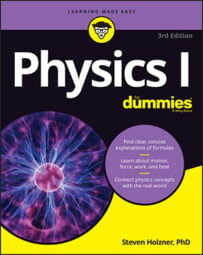In physics, you can calculate the acceleration of an object in simple harmonic motion as it moves in a circle; all you need to know is the object’s path radius and angular velocity.
You can find the displacement of an object undergoing simple harmonic motion with the equation
and you can find the object’s velocity with the equation
But you have another factor to account for when describing an object in simple harmonic motion: its acceleration at any particular point. How do you figure it out? No sweat. When an object is going around in a circle, the acceleration is the centripetal acceleration, which is

(that is, the angular velocity in the direction of the [constant] axis of rotation). And because r = A — the amplitude — you get the following equation:
This equation represents the relationship between centripetal acceleration, a, and angular velocity,
To go from a reference circle to simple harmonic motion, you take the component of the acceleration in one dimension — the y direction here — which looks like this:
The negative sign indicates that the y component of the acceleration is always directed opposite the displacement (the ball always accelerates toward the equilibrium point). And because
where t represents time, you get the following equation for acceleration:
Now you have the equation to find the acceleration of an object at any point while it’s moving in simple harmonic motion.
For example, say that your phone rings, and you pick it up. You hear “Hello?” from the earpiece.
“Hmm,” you think. “I wonder what the maximum acceleration of the diaphragm in the phone is.” The diaphragm (a metal disk that acts like an eardrum) in your phone undergoes a motion very similar to simple harmonic motion, so calculating its acceleration isn’t any problem. Measuring carefully, you note that the amplitude of the diaphragm’s motion is about
So far, so good. Human speech is in the 1.0-kilohertz (1,000 hertz) frequency range, so you have the frequency,
And you know that the maximum acceleration equals the following:

You get a value of about 3,950 meters per second2. That seems like a large acceleration, and indeed it is; it’s about 403 times the magnitude of the acceleration due to gravity! “Wow,” you say. “That’s an incredible acceleration to pack into such a small piece of hardware.”
“What?” says the impatient person on the phone. “Are you doing physics again?”

